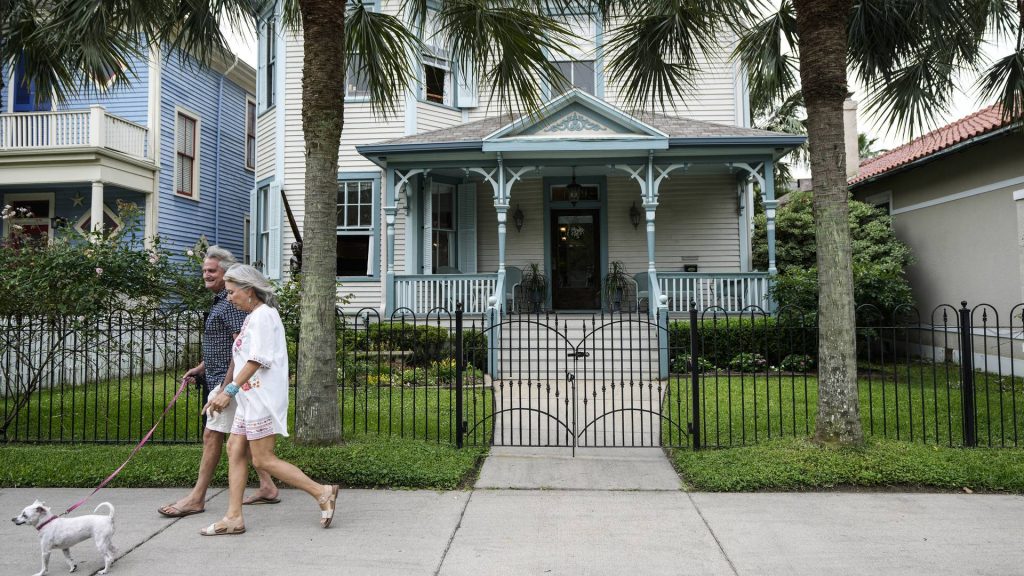A clog in the housing pipeline: Baby boomers don’t want to move out

The housing pipeline counts on a continuous stream of buyers entering and longtime homeowners exiting. Buyers abound.
Sellers, not so much, in no small part due to firmly lodged baby boomers, many of whom bought their houses in the 1960s, 1970s and 1980s, and who have enjoyed an exponential rise in home equity. Boomers insist on staying put: 61% claimed they won’t ever sell their houses – up from 54% last year, according to a September survey by selling platform Clever Offers.

What will it take to uproot baby boomers?
It’s obvious and easy to blame tax policies and a preference for home-based medical care, but those rationales mask deeper barriers to loosening the bottleneck, financial advisors and real estate experts told Straight Arrow News.
“Most people prefer to age in place, which is fine if you’re planning for it and you can pay for it,” said Eric Ludwig, director of the Center for Retirement Income with the American College of Financial Services. “I’ve had plenty of clients who thought, ‘I can take care of Dad’ at home, and it works until it doesn’t.”
While changing tax policies relevant to long-term homeownership is the obvious solution, housing experts told SAN it’s also the least likely to have a meaningful effect.
The longstanding capital gains tax on assets, such as real estate, that a family has held for over a year, usually kicks in at $250,000 for singles or $500,000 for married couples. Depending on a host of other factors, such as the adjusted cost basis, the tax on the remaining gain in value could reach 25%, per the IRS.
Some states have formulas for offsetting some of the tax consequences of selling a long-owned home, said Tim Carr, deputy chair of the Department of Real Estate & Urban Land Economics at the Wisconsin School of Business. His own mother ran into a confounding web of tax consequences. Moving to a condo would have propelled her longtime house into the real estate pipeline. But it wasn’t affordable, as a condo came with higher property taxes than she paid on her home. She stayed in the house.
Tax policies are easy targets because they appear to be a quantitative, logical way to align economic incentives with the move-up-or-out housing pipeline. But off-balance-sheet factors defy logic.

How do older Americans feel about homeownership?
The Clever survey found that 66% of respondents cited owning a house as “one of their greatest financial achievements,” and 83% said they expected to forfeit independence if they left their houses to move in with family or into a retirement community.
“For the affluent set, the capital gains tax is almost used as an excuse to not vet options outside the existing house,” said Tom West, a senior partner with the investment management and financial planning firm Signature Estate & Investment Advisors.
“But the math sometimes is a nothingburger. Let’s talk about medical diagnoses, chronic illnesses, what’s going on with the family and the kids. Sometimes there are cognitive issues that affect complicated issues like moving out of the house,” West told SAN. “That’s often the root cause of the intransigence and resistance to change, and they’ll hide behind the capital gains tax to put off those decisions.”
Since boomers bought their first houses, the cost of homeownership has risen much faster than the typical American’s earnings. It’s not news that houses are unaffordable for debt-laden millennials and Gen Z.
But at the same time, another trend is reshaping generational patterns of homeownership: the expectation that the elder generation’s house is a family asset, and that younger generations have a claim on it. These days, nearly half of adults younger than 30 live at home, the highest proportion since the Great Depression.
Add in the preference for boomers to “age in place,” and the stage is set for the family house to pass from one generation to the next without ever going on the open market.
Older adults’ hopes to stay in their houses were reinforced during the pandemic, when older adults in institutional care were isolated from their families. The pandemic accelerated a long-term move toward home-based care, exercised through policies of two federal programs: Medicare, which covers Americans aged 65 and older, and Medicaid, which covers low-income Americans. Telehealth and “virtual hospital” care at home have expanded in the past several years – at least, until the October shutdown of the federal government.
So far, medical and tax incentives converged to justify seniors’ intentions to stay in their longtime homes: 84% of boomers say they intend to age in place with the help of long-term care at home, according to an October study by insurer Northwestern Mutual. That expectation spans all generations, with 74% of all Americans aiming to stay in their homes as long as possible.

Should we think of homes as assets or as a place to live?
The challenge is for older adults to define “home” less as an owned asset and more as a secure and sustainable place to live, said Elena Portacolone, a professor at the Institute for Health & Aging with the University of California, San Francisco.
Portacolone said there are options in the middle of the spectrum between staying in an owned house and moving to institutional care.
Renting out part of the house to extract cash flow from the home can help pay for professional care, for example. Portacolone also pointed to reverse mortgages or plans in which family members pay for their anticipated ownership stake through home maintenance.
Ultimately, families need to find sustainable ways to make long-owned homes work for elders and the entire family, said Samara Scheckler, a senior research associate at the Harvard Joint Center for Housing Studies, who studies the intersection of elder care and housing.
Already, analysis that she and her colleagues have conducted indicates that 75% of American households headed by those age 75 and older cannot afford the long-term care they need. Continuing in their homes is less expensive than moving to retirement communities. But as care needs increase, many can’t afford at-home services either. Even if they sold their houses, they might not have enough to pay for escalating levels of institutional care for the rest of their lives.
“For some, a multigenerational household will be a good solution,” Scheckler told SAN.
Multigenerational households are culturally congruent with many Black, Asian and Hispanic families, said Scheckler. These cultural preferences likely explain, at least in part, the rise in young adults who live with their parents and expect to inherit the family house. A survey sponsored by insurer Choice Mutual found that 69% of Americans expect to inherit real estate.

How common is it for homes to be handed down by generation?
For middle-class and working families, the oldest generation’s houses are now considered generational assets, says Anthony Martin, CEO of Choice Mutual.
“Often, they live with their parents, and their game plan is, that because they’re the ones caring for their parents, they’ll get the house,” he told SAN.
As older adults come to terms with their late-in-life capabilities, they have the chance to redefine “independence” and, with that, their definition of home, said Brad Breeding, managing partner of MyLifeSite, a firm that advises consumers and retirement communities.
Receiving care in their long-time homes can help boomers adjust to the idea of moving to a retirement community or even assisted living.
“People feel like leaving their home means giving up independence,” Breeding told SAN. “But those things can change. For some, independence is being in control of their schedules and decisions.”
Boomers can’t hold on forever. For one thing, the millions of split-level and two-story houses bought by boomers decades ago can’t be readily retrofitted for safe, sustainable one-story living — especially not in time to accommodate rapidly aging elders. As rising generations start to take the financial reins, they’ll be in a position to raise difficult topics, especially to head off elder care crises.
“Power of attorney is a way to wake up the younger generations and ask the right questions,” West told SAN. “I always like giving adult children the perspective that in the event that mom and dad can’t do it for themselves, do you know what they want you to do with and for them?”
The post A clog in the housing pipeline: Baby boomers don’t want to move out appeared first on Straight Arrow News.





